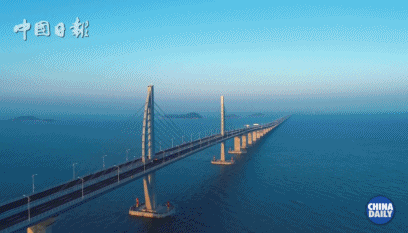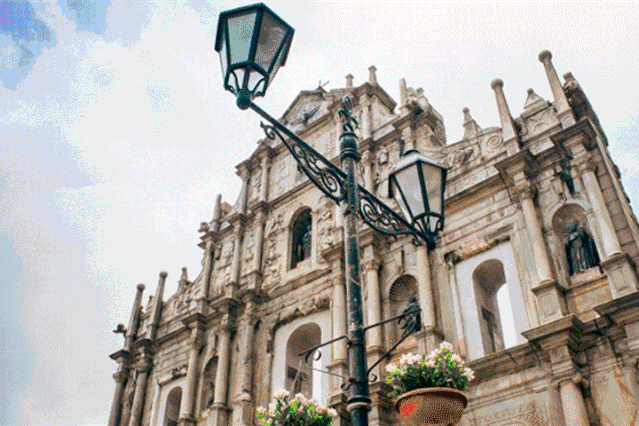
导读
I'm standing in front of you and talking about my past experiences, and sharing my story with Macao and the Greater Bay Area with you.
So my story started in 1994.
At that point, Macao, of course, was already preparing toward its handover in 1999. And Macao residents were looking forward to the opening of the Macao International Airport. Macao was becoming a Special Administrative Region (SAR), and understood the importance of building for itself the capability of welcoming international travelers, as well as, of course, linking back to the Chinese mainland.
我有幸被任命为公司代表,代表公司参与澳门国际机场以及第一条航线的建设。
I was so lucky to have been designated as the corporate representative to represent our company's interests in the Macao International Airport, as well as in its first airline in Macao. 
So this picture, what's this all about? You see an airplane linking to the sea, or the ferry. That's one of my first assignments as well.
In 1995, I became the general manager of Shun Tak Holdings. And my first assignment was to restructure also our own ferry business, and then that was the creation of a new joint venture with China Travel.
It was one of the earliest, in fact, probably, the first-ever joint venture between Hong Kong and a Macao company with a SOE, state-owned-enterprise, China Travel.
In the beginning, we were competitors. We actually were enemies in a way. But then we resolved it by creating a collaborative activity, rather than to compete. We all have one common objective, how to create, so that this region would come together, rather than to go about, basically competing with each other.
Then, we started thinking, well, now we have the airport in Macao, we also have, of course, an airport that was almost 100 times the size of Macao, in Hong Kong, Chep Lak Kok.
Was there a way to link the two?
Was there a way, like in the example of the ferries, to do this? In fact, distance-wise, you all know by now, because with the bridge, we are practically only 15 km away between the two airports.

How do we make best use and create synergies, rather than, again, duplication, you know, in resources?
I said, why don't we connect the two airports? Everybody looked and said, why?
Well, you know, because maybe there would be people who would come internationally to Hong Kong, but then also would like to travel to Macao and other parts of China, via the ferries.
Really? Yes. Really, you know. Why not?
Because these people, when they come to Hong Kong now, as an SAR, they also would like to utilize Hong Kong. Beyond that, the geographic transportation infrastructure.
In year 2000, we actually opened the Macao Tower, which, you will see, driving across the harbor, Dr. Stanley Ho, to our motherland, and was hoping that the actual handing over ceremony was going to be conducted there.
But then, of course, the construction work was a little bit more complicated, there was delay, so finally we missed the 1999 date 20 years ago. Instead, though, it opened in 2000.
And, again, everybody looked at it and said, so what do we now want to do with it? So I said, we definitely do not want to put in another casino.
We want to make sure that Macao now embarks on a new journey. And we need to be visualizing with a long view.
With the perspective, how does Macao become a player in this region?
So even before the Greater Bay Area, we started thinking, so what is it?
Tourism.

We came up with the idea of simply driven from the mere fact that Macao needs its neighbors. Otherwise, just as a standalone destination, there's never going to be enough to create for ourselves the economy of scale.
We understand that. So we need to work even harder than Hong Kong, for instance, to make sure that we work with Guangdong, we work with our neighboring ports and cities.
So, at the Macao Tower, it was the first place we created with the notion and concept of MICE ——Meetings, Incentives, Conventions, Exhibitions.
Again, very very early on, a pioneering concept that people were saying, who would come to Macao for meetings?
We are here now in Macao for meetings, so thank you very much for proving that this works.
Eight years ago, again, under my auspice, I created the notion of an art space. People were, a little bit, perplexed. Why do we need art, you know?
Aren't we a place that people only know of, about just the entertainment, just, maybe the gaming attraction? So, yes.
But art is going to be there for a longer time, simply because again, we need to find common ground to bring us closer with the Greater Bay Area.
We share a lot of these cultural identities, all of us, we Cantonese, all of us sharing on our, what we call, the Cantonese, or even tracing back in history, Lingnan Culture.
So my job has been now focusing more on exploring how do we make art and cultural development to become part of our now new future, and how do we utilizing that to link with our neighbors within the Greater Bay Area.
So in the future, we are going to work on what we call 'Tourism+' concept. We need to not just focus on Macao's own development, but the development of the whole Greater Bay Area,and create a tourism hub, that we can pool our resources together in the future and sell our products together.
Only then can long-range travelers decide to come and spend not just a day or two, but rather, hopefully, you know, a few days of their holidays' time, and to explore the whole of the Guangdong province.
I'll give you an example. Just two weeks ago, every year now in this property, we host a Lion Dance Championship.
The Lion Dance is actually one of the cultural aspects of the Lingnan Culture. And through that, it can also be a means of bringing together the whole of the Greater Bay Area, especially instilling in the youth, our young people, a sense of belonging.
We will work with Shenzhen, for instance, on building Macao as what we call, a smart city.
We will work with Guangzhou, for instance, to leverage on their tourism figures, which is obviously very substantial, to help and also, make sure that we both are able to capture more of international travelers.
And we can also, obviously, work with Hong Kong, which is, of course, the major cosmopolitan, and the leader in trends and fashion.